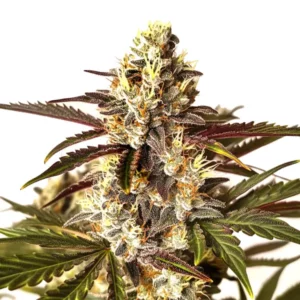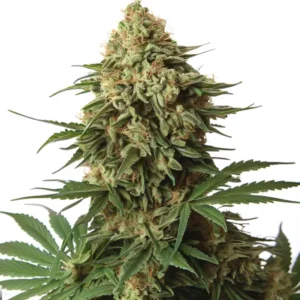
Cannabis Aroma Metabolic Pathways
Cannabis aroma is a fascinating subject for both novice seed buyers and seasoned growers. The aroma of cannabis is not just a pleasant byproduct; it’s a complex signature of the plant’s genetic makeup. Dive into the world of cannabis aroma metabolic pathways, and you’ll find an intricate network of reactions and compounds.
The metabolic pathways of cannabis aroma compounds are the routes through which these scents are created. In these pathways, simple molecules are transformed by enzymes into the aromatic compounds that give cannabis its distinctive smell. Each strain has its unique pathway, resulting in a variety of scents that attract consumers and cultivators alike.
Recommended Strains
Strawberry Cough
|
|
THC | 19% - 23% (Medium) |
|
|
Type | Feminized |
|
|
Yield | Medium |
|
|
Phenotype | 30% Indica / 70% Sativa |
Gelato
|
|
THC | 27% (High) |
|
|
Type | Feminized |
|
|
Yield | High |
|
|
Phenotype | 50% Indica / 50% Sativa |
Consider the function of enzymes in cannabis aroma production. Enzymes act as biological catalysts, speeding up the chemical reactions in the plant. Without them, the diverse scents of cannabis would not exist. These enzymes are influenced by genetic factors, meaning every strain has a unique aromatic signature.
Terpene Biosynthesis in Cannabis Plants
Terpenes are the primary compounds responsible for the aroma of cannabis. The terpene biosynthesis in cannabis plants involves a series of chemical reactions that transform basic organic molecules into the diverse array of terpenes we smell. This process is pivotal in determining the final scent profile of a cannabis plant.
Let’s look at a real-life example. The strain Gelato boasts a sweet aroma, reminiscent of a dessert. This is due to its unique terpene profile, primarily composed of linalool and pinene. These terpenes are synthesized through specific metabolic pathways, making Gelato stand out in the ever-growing cannabis market.
Knowing terpene biosynthesis in cannabis plants is crucial for breeders and researchers aiming to enhance specific aromatic profiles. By manipulating the genetic factors influencing cannabis scent, it is possible to create strains with higher concentrations of desirable terpenes. This tailoring of aroma not only satisfies consumer demands but also contributes to the plant’s ecological interactions.
The complexity of terpene biosynthesis in cannabis plants highlights the intricate nature of cannabis aroma metabolic pathways. These pathways are not only integral to the plant’s aroma but also play a role in its overall health and resilience. By exploring these pathways further, we can unlock new potential in cannabis cultivation and breeding.
Impact of Cannabis Aroma on Consumer Preference
The impact of cannabis aroma on consumer preference is significant. Many consumers choose strains based on their scent, which is a direct result of the plant’s metabolic pathways. When someone smells cannabis, they are experiencing a complex blend of terpenes and other aromatic compounds.
Consider a visit to a cannabis dispensary. Often, consumers will open jars of different strains, taking in the aroma before making a purchase. A strain with a strong, appealing scent is more likely to be chosen over a less aromatic one. This highlights the importance of knowing cannabis aroma metabolic pathways for both growers and sellers.
The impact of cannabis aroma on consumer preference extends beyond mere scent. It influences brand loyalty and market trends, as consumers often associate specific aromas with quality and potency. By focusing on the metabolic pathways of cannabis aroma compounds, producers can strategically position their products in a competitive market.
Furthermore, the impact of cannabis aroma on consumer preference underscores the need for education and marketing strategies that highlight the unique aromatic profiles of different strains. Educating consumers about the function of enzymes in cannabis aroma production and the genetic factors influencing cannabis scent can enhance their purchasing experience.
Promos & Deals
Genetic Factors Influencing Cannabis Scent
Genetic factors play a crucial role in influencing cannabis scent. Each strain’s genetic makeup determines the enzymes available for terpene biosynthesis. This means that the genetic profile of a plant directly affects its aromatic profile.
When breeding cannabis, growers often select strains with desirable aromatic qualities. For example, a breeder might choose a strain with a strong, fruity scent like Strawberry Cough. By knowing the genetic factors influencing cannabis scent, breeders can cultivate plants with specific aromatic traits, enhancing consumer satisfaction.
Genetic factors influencing cannabis scent are not solely responsible for aroma diversity; environmental conditions also play a role. However, by focusing on genetics, breeders can ensure consistency in aroma production across different growing environments. This allows for the reliable reproduction of sought-after scent profiles.
Exploring the genetic factors influencing cannabis scent can lead to breakthroughs in enhancing plant resilience and adaptation. By identifying genes linked to specific metabolic pathways, researchers can develop strains that not only smell appealing but also exhibit improved growth and resistance to environmental stressors.

Role of Enzymes in Cannabis Aroma Production
In the realm of cannabis aroma, enzymes are the unsung heroes. These proteins accelerate the chemical reactions necessary for terpene biosynthesis. Without enzymes, the metabolic pathways that create cannabis aroma would be inefficient and slow.
Enzymes work by lowering the energy required for a reaction to occur. In cannabis plants, this means that the transformation of basic organic compounds into aromatic terpenes happens more rapidly and efficiently. This is essential for the plant’s survival and its ability to attract pollinators and repel pests.
The function of enzymes in cannabis aroma production is further highlighted by their specificity. Each enzyme targets particular substrates, leading to the formation of distinct terpenes. This specificity is dictated by the plant’s genetic makeup, which ultimately shapes the aromatic profile of each strain.
Research into the function of enzymes in cannabis aroma production opens new avenues for enhancing aroma through genetic engineering and selective breeding. By pinpointing and manipulating key enzymes within the metabolic pathways of cannabis aroma compounds, it is possible to create strains with novel and desirable scents.
FAQs
What are cannabis aroma metabolic pathways?
Cannabis aroma metabolic pathways are the series of biochemical reactions that occur within the cannabis plant to produce its unique scent. These pathways involve the transformation of simple organic molecules into complex aromatic compounds, primarily terpenes.
As cannabis grows, these pathways are activated, leading to the production of the plant’s distinct aroma. This scent not only attracts consumers but also plays a role in the plant’s interaction with its environment, including pollinators and pests.
Knowing cannabis aroma metabolic pathways is vital for both breeders and consumers. By decoding these pathways, breeders can enhance specific aromatic traits, while consumers can make informed choices based on the scent profiles that appeal to them most.
Furthermore, cannabis aroma metabolic pathways are a testament to the complexity of plant biochemistry. They reveal the intricate network of reactions that underpin the diverse aromatic qualities that make cannabis so unique and desirable in the marketplace.
How do genetic factors influence cannabis scent?
Genetic factors determine the specific enzymes present in a cannabis plant, which in turn influence its aromatic profile. Each strain has a unique genetic code, resulting in a distinct set of enzymes that dictate the plant’s scent.
By selecting for specific genetic traits, breeders can influence the aroma of cannabis. This allows them to create new strains with desired aromatic characteristics, enhancing the plant’s appeal to consumers.
Genetic factors influencing cannabis scent also contribute to the plant’s adaptability and resilience. By knowing these genetic determinants, breeders can develop strains that not only smell appealing but are also better suited to withstand environmental challenges.
Exploration of genetic factors influencing cannabis scent is an ongoing area of research, with the potential to unlock new possibilities in cannabis cultivation. By leveraging genetic insights, it is possible to craft strains that meet evolving consumer preferences and industry standards.
Why are terpenes important in cannabis aroma?
Terpenes are the primary components of cannabis aroma. These organic compounds are responsible for the diverse scents found in different cannabis strains. Terpenes not only define a strain’s aroma but also contribute to its flavor and potential therapeutic effects.
The biosynthesis of terpenes in cannabis plants is a complex process involving multiple metabolic pathways. Knowing these pathways helps growers produce strains with specific aromatic profiles, catering to consumer preferences.
The importance of terpenes in cannabis aroma extends beyond scent; they also interact with cannabinoids to influence the overall effects of a strain. This phenomenon, known as the entourage effect, underscores the significance of terpene biosynthesis in cannabis plants.
Terpenes also play a crucial role in the ecological interactions of cannabis plants, aiding in the attraction of beneficial organisms and the deterrence of pests. This ecological function further emphasizes the importance of knowing and optimizing terpene production through the study of metabolic pathways.
What is the impact of cannabis aroma on consumer preference?
Cannabis aroma significantly impacts consumer preference. Many buyers choose strains based on their scent, as it provides a sensory indication of the plant’s quality and effects. A pleasing aroma can make a strain more desirable and marketable.
In dispensaries, consumers often rely on smell to guide their purchasing decisions. Strains with strong, attractive aromas are more likely to be selected, emphasizing the importance of aroma in the cannabis industry.
The impact of cannabis aroma on consumer preference is also linked to cultural and historical contexts. Different regions and demographics may have varying preferences for certain aromatic profiles, highlighting the need for diverse offerings in the market.
Besides to immediate sales, the impact of cannabis aroma on consumer preference can foster long-term brand loyalty. Strains associated with memorable and appealing scents often become consumer favorites, driving repeat purchases and word-of-mouth recommendations.
How do enzymes contribute to cannabis aroma production?
Enzymes are crucial for the production of cannabis aroma. These proteins facilitate the biochemical reactions needed to synthesize terpenes and other aromatic compounds. Enzymes speed up these processes, allowing the plant to efficiently produce its scent.
Each strain of cannabis has a specific set of enzymes, influenced by its genetics. This enzymatic diversity leads to the wide range of aromas found in different cannabis strains, making enzymes a key factor in aroma production.
The contribution of enzymes to cannabis aroma production is not limited to the plant’s life cycle; it also affects post-harvest aroma retention. Knowing enzyme activity can help optimize storage and processing techniques to preserve the desired scent profiles.
Advancements in biotechnology offer new possibilities for enhancing the function of enzymes in cannabis aroma production. By engineering enzyme pathways, it may be possible to develop strains with unprecedented aromatic characteristics, setting new trends in the cannabis industry.




















